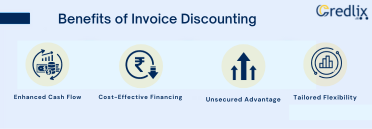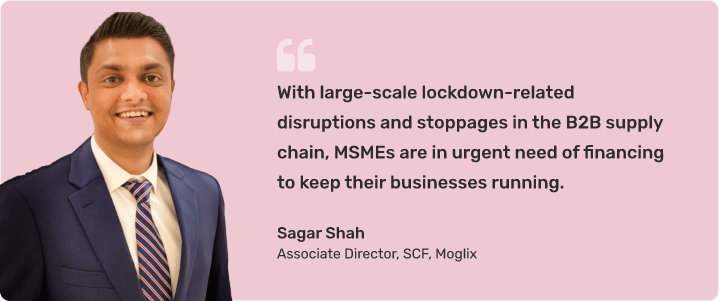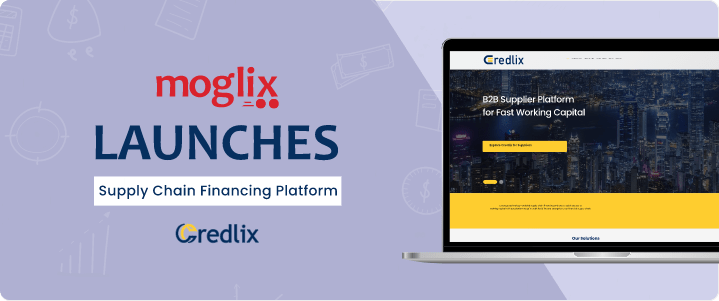
Explore the dynamic realm of invoice discounting, a financial strategy empowering businesses to access capital by leveraging their outstanding invoices ahead of schedule. This method serves as a potent cash flow solution, offering a timely infusion of funds to fuel operational needs.
However, the pursuit of this financial avenue demands a keen awareness of associated credit risks, necessitating adept risk management. This blog delves into the intricacies of this financing approach, emphasizing the importance of safeguarding your business against potential credit pitfalls.
Uncover the nuanced strategies and protective measures essential for navigating the landscape of invoice discounting, ensuring a harmonious balance between financial empowerment and risk mitigation for sustained business resilience.
Mitigating Credit Risks in Invoice Discounting
Safeguard your finances with strategic measures, navigating credit risks effectively in the realm of invoice discounting for business stability.
Verify Client Credit
Prior to discounting an invoice, it’s crucial to verify your client’s credit. Ensuring a positive credit history is essential to mitigate the risk of payment defaults. This practice allows for early identification of potential issues, helping steer clear of high-risk clients.
By conducting thorough credit checks, businesses can establish a secure foundation, fostering confidence in transactions and minimizing the likelihood of payment challenges down the line.
Client Payment Behavior Oversight
Stay vigilant by monitoring your clients’ payment habits. Watch for delays or late payments, as these can signal cash flow troubles. Early detection allows prompt action to prevent minor issues from escalating into more significant challenges.
Keeping a close eye on payment behavior safeguards your business, ensuring proactive measures to maintain a healthy financial flow and foster smoother transactions with clients.
Smart Credit Limits
To lower risks, establish credit limits tailored to each client’s creditworthiness and payment history. This practice prevents excessive risk exposure with any one client, ensuring a balanced and secure financial approach.
By setting appropriate credit limits, businesses can navigate confidently, minimizing potential challenges associated with clients’ credit behavior and fostering a stable and sustainable working relationship.
Invoice Insurance
Explore the safety net of invoice insurance to shield your business from non-payment risks. By opting for this coverage, you mitigate the financial impact of unpaid invoices, ensuring your business stays resilient. In the unpredictable landscape of business transactions, invoice insurance becomes a crucial tool for safeguarding against potential losses.
Partnering Wisely in Invoice Discounting
Opt for an invoice discounting provider like Credlix renowned for adept credit risk management. Select a reputable partner with a proven track record and comprehensive services to effectively mitigate credit risks. Choose a provider with a strong reputation, ensuring your business is in capable hands for secure and reliable invoice discounting solutions.
Clear Agreements for Smooth Transactions
Make sure there’s a clear contract among you, the supplier, and the invoice discounting provider. This document should outline agreement terms, credit limits, and what happens if the client can’t pay. A transparent contract prevents misunderstandings and ensures everyone knows their responsibilities, fostering smooth transactions.
Maintain Precise Records for Invoice Discounting
Keep careful records when using invoice discounting. Track all invoices and payments accurately and ensure they’re up-to-date. This helps quickly spot and fix any mistakes or issues.
Fostering Client Bonds for Financial Harmony
Cultivate robust client relationships to minimize late payments or defaults. Clear communication on payment obligations and outstanding customer service builds trust, fostering timely payments. Strengthening these connections not only ensures a smoother business rapport but also contributes to a reliable and harmonious financial partnership.
Diversify Your Client Portfolio
Avoid heightened credit risk by diversifying your client base. Dependence on a single client or a small group raises vulnerability. To counter this, engage with a variety of clients across different industries. Diversification safeguards against over-reliance on any one client or sector, promoting a more resilient and adaptable business model. By broadening your client portfolio, you enhance your ability to navigate economic fluctuations and potential challenges, ensuring a stable foundation for sustained business success.
Proactive Credit Risk Management for Stability
Take a proactive stance in credit risk management. Regularly monitor clients’ payment behaviors and swiftly address any concerns. Be ready to renegotiate credit limits or initiate legal measures when necessary. Always have a well-thought-out contingency plan to effectively navigate and mitigate potential risks.
Being proactive ensures you stay ahead of challenges, maintaining financial stability and safeguarding your business against uncertainties. A vigilant and responsive approach to risk management forms a crucial aspect of sustaining a resilient and thriving business.
Invoice discounting boosts cash flow, yet entails credit risks. Mitigate by thorough credit checks, setting limits, using invoice insurance, partnering with a reputable provider, and proactive risk management. Securely enhance cash flow while safeguarding your business.
Top 5 Invoice Discounting and Credit Risks
Explore the key challenges in invoice discounting. Navigate credit risks effectively with insights into the top 5 considerations for businesses.
1. Non-Payment Risk
The primary concern in invoice discounting is non-payment. When a client doesn’t fulfill their invoice payment, the lender faces the challenge of unpaid debt, impacting cash flow and profitability significantly. Mitigating this risk involves careful client assessment and proactive measures to address potential payment issues promptly.
2. Fraud Vulnerability
Invoice discounting exposes businesses to the risk of fraudulent invoices or clients. Submission of false invoices can lead to financial losses when the actual client doesn’t pay. Preventing fraud involves rigorous verification processes and heightened awareness to detect and counteract fraudulent activities, safeguarding the integrity of the discounting process.
3. Concentration Risk Simplified
Putting too much trust in just one or a few clients can be risky. If these clients face money problems or close down, it’s called concentration risk. This risk can seriously affect the lender’s money flow and how much they earn.
4. Credit Risk Made Easy
Lenders offering invoice discounting need to be careful about their clients’ creditworthiness. If a client doesn’t have a good history of paying debts or might not pay on time, it raises credit risk for the lender. This risk can directly impact how much money the lender makes from providing invoice discounting services.
5. Operational Risks
Invoice discounting introduces operational risks, including processing errors and client disputes on payment terms. These challenges directly affect the lender’s cash flow and reputation.
To counter these risks, businesses should implement comprehensive measures. Conducting detailed credit checks, setting credit limits, monitoring payment behavior, maintaining precise records, diversifying the client base, and collaborating with reputable invoice discounting providers are crucial steps. These actions empower businesses to proactively manage the inherent risks associated with invoice discounting, safeguarding both cash flow and profitability.
Benefits of Invoice Discounting

Boost cash flow, enhance liquidity, and improve financial flexibility with the advantageous solution of invoice discounting.
1. Enhanced Cash Flow
Invoice discounting acts as a financial catalyst, turning outstanding invoices into accessible cash flow. This liquidity empowers businesses to promptly settle bills, cover operational expenses, and seize growth opportunities, fostering a dynamic and responsive financial environment.
2. Cost-Effective Financing
Choosing invoice discounting proves economical, offering a financing alternative with lower interest rates compared to conventional bank loans or credit lines. This cost-effectiveness positions businesses to efficiently manage financial resources and allocate funds strategically for sustained growth.
3. Tailored Flexibility
Invoice discounting stands out for its adaptability, allowing businesses to tailor financing to their unique needs. This flexibility means accessing funds from invoices precisely when required, offering freedom from rigid repayment schedules and promoting financial agility aligned with business dynamics.
4. Unsecured Advantage
The unsecured nature of invoice discounting is a significant advantage, eliminating the need for businesses to provide collateral. This characteristic enhances accessibility to financing, particularly beneficial for businesses lacking substantial assets for collateral, ensuring a secure and viable financial solution.
Credit Facilities Benefits
Credit facilities offer financial flexibility, enabling businesses to meet varying needs and navigate economic fluctuations seamlessly.
1. Enhanced Working Capital Access
Credit facilities act as a financial lifeline, granting businesses crucial working capital. This accessible capital becomes a versatile resource, facilitating bill payments, fueling growth ventures, and covering various operational expenses, empowering businesses for dynamic financial maneuvering.
2. Tailored Flexibility
Providing adaptability, credit facilities cater to diverse business needs. Businesses can secure funds as required, escaping rigid repayment structures. This flexibility ensures a responsive financial strategy aligned with the ever-changing demands of business operations and growth aspirations.
3. Streamlined Cash Flow
Credit facilities prove instrumental in effective cash flow management, offering businesses timely access to essential funds. This proactive approach safeguards against cash flow challenges, ensuring timely bill payments and sustaining financial health in dynamic market conditions.
4. Unsecured Accessibility
The unsecured nature of credit facilities stands as a pivotal advantage, eliminating the necessity for collateral. This accessibility proves beneficial for businesses lacking substantial assets, offering a secure financial solution without the need for pledging collateral.
Conclusion
In conclusion, understanding the nuances of invoice discounting and credit facilities is crucial for businesses seeking financial empowerment. While these methods offer significant benefits like improved cash flow, flexibility, and reduced financing costs, they come with inherent risks.
Mitigating these risks demands a proactive approach, encompassing thorough credit checks, strategic credit risk management, and a commitment to fostering strong client relationships. The careful implementation of protective measures ensures that businesses can harness the advantages of these financial strategies while maintaining stability and resilience.
Also Read: What are the Types of Invoice Discounting?
FAQs
What is the primary benefit of invoice discounting?
Invoice discounting provides businesses with improved cash flow by converting outstanding invoices into accessible funds.
How does invoice discounting differ from traditional loans?
Unlike traditional loans, invoice discounting offers flexibility, allowing businesses to borrow funds as needed without fixed repayment schedules.
What is concentration risk in invoice discounting?
Concentration risk in invoice discounting arises when a business relies too heavily on one or a few clients, increasing the risk of default.
Why is credit risk management essential in invoice discounting?
Credit risk management is crucial to assess and mitigate the risk of non-payment, ensuring financial stability and profitability.
Can businesses with no collateral benefit from invoice discounting?
Yes, invoice discounting is often unsecured, providing a financing option for businesses without substantial assets for collateral.
How does credit facilities help in effective cash flow management?
Credit facilities provide timely access to funds, aiding in managing cash flow effectively and ensuring on-time bill payments.
Are credit facilities suitable for businesses with fluctuating financial needs?
Yes, credit facilities offer tailored flexibility, allowing businesses to secure funds as required, making them suitable for varying financial needs.
Also Read: Why Most MSMEs Prefer Invoice Discounting in India


















